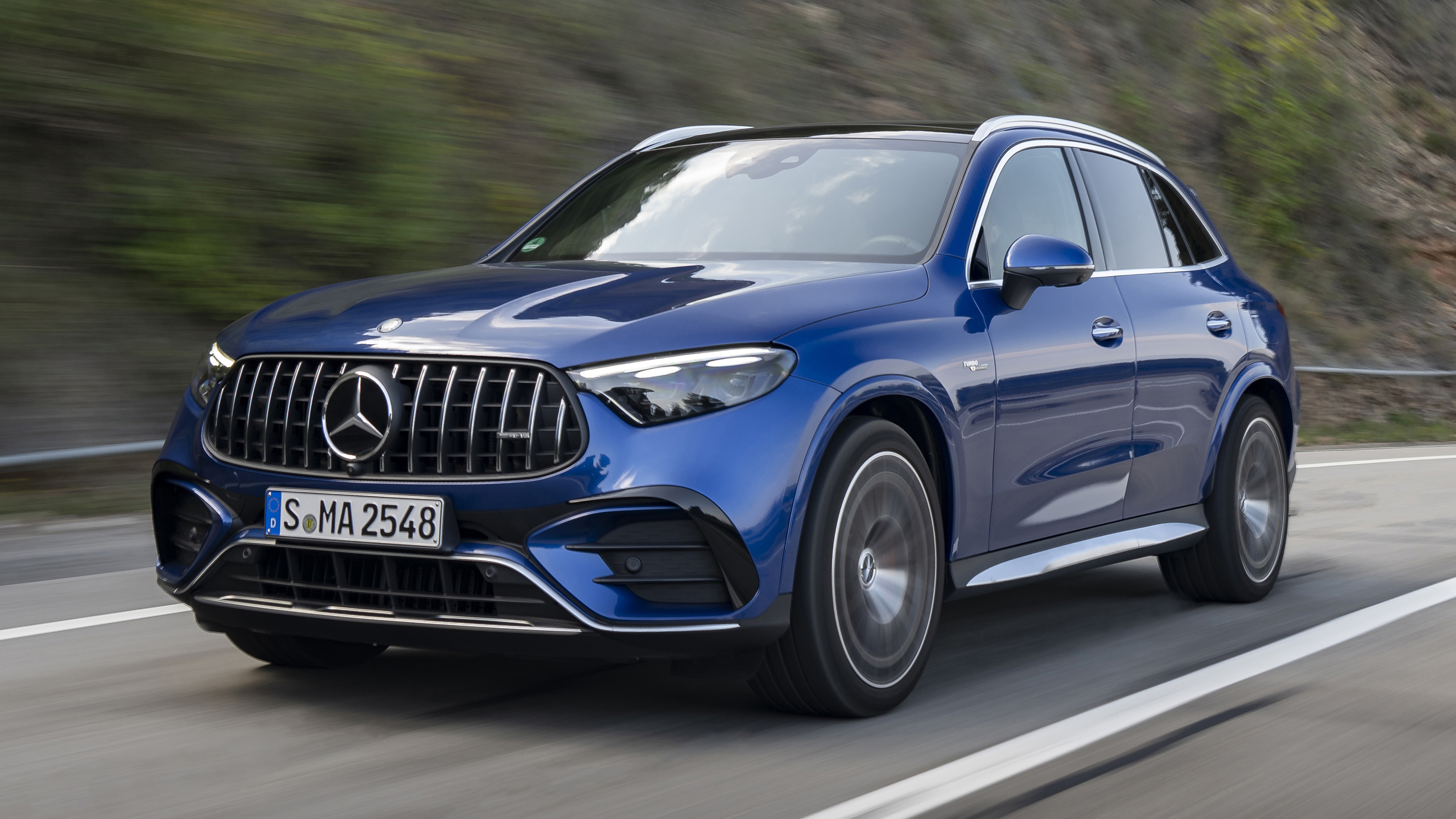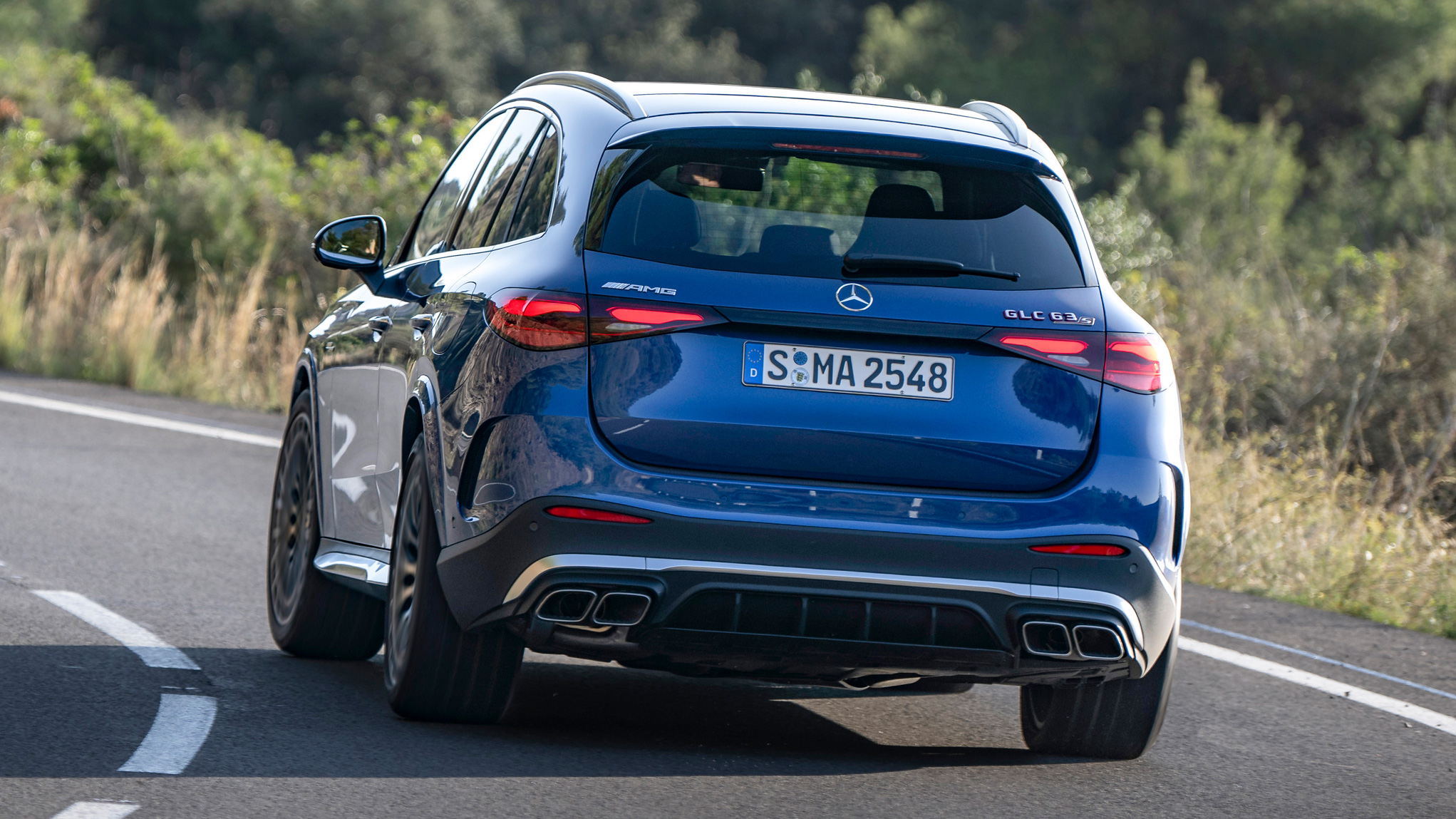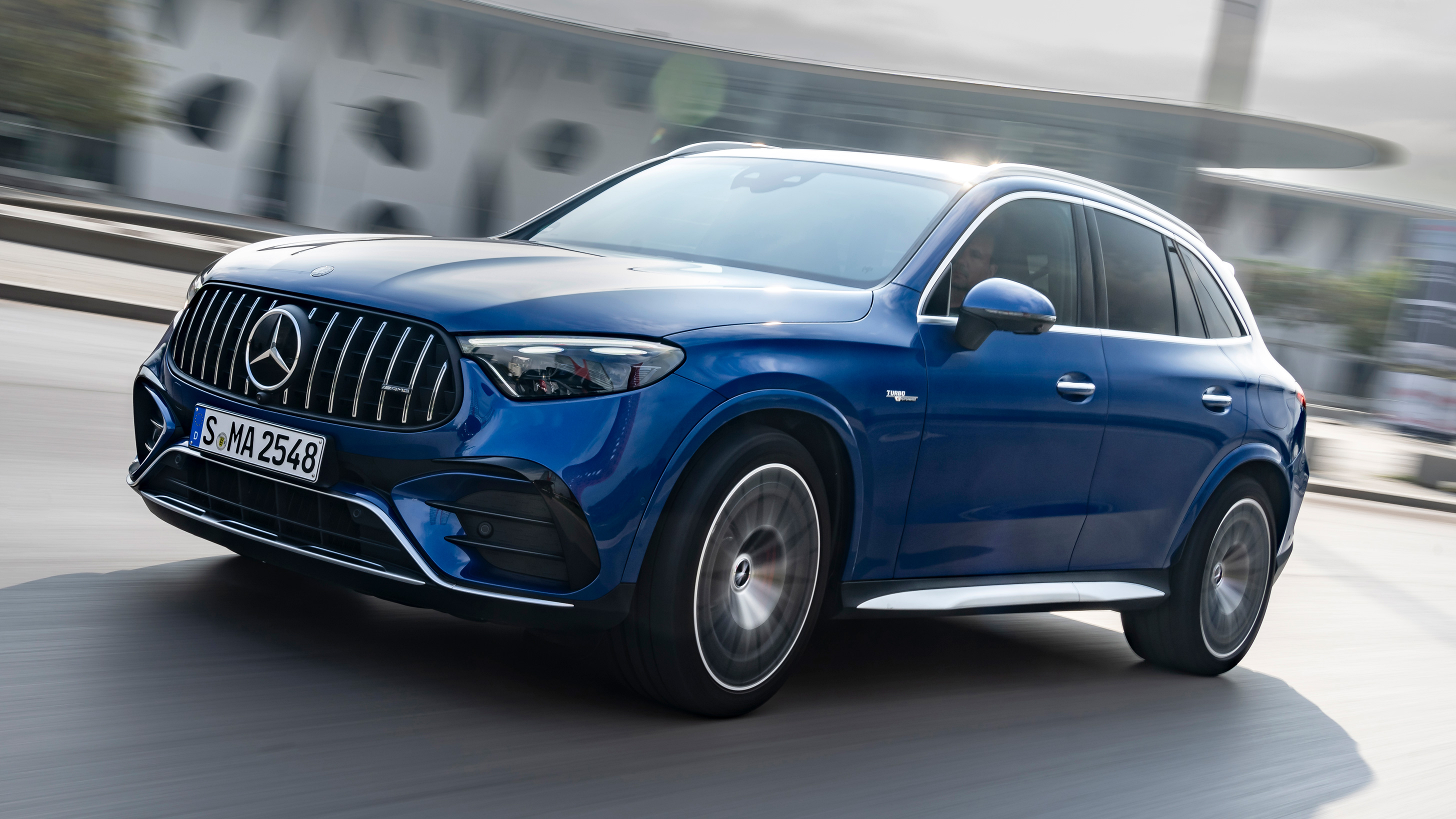
SPEC HIGHLIGHTS
- Battery
Capacity6.1kWh
- BHP
670.5bhp
- 0-62
3.5s
- Max Speed
171Mph
What is this, then?
A car that goes big whichever yardstick you’re measuring it against. The Mercedes-AMG GLC 63 S E Performance allies a hefty 671bhp powerplant to a 2,310kg body that happens to be wearing a £108,995 price tag. And yeah, its name is pretty sizeable too.
I don’t know where to start…
Let’s start by winding the clock back ten whole months to our first go in this car’s saloon and estate sibling, the latest Mercedes-AMG C63. It’s not a car that bowled us over, its four-cylinder hybrid setup feeling overwrought after the muscle car swagger of its older namesakes.
Well, this is the first time we’ve got our hands on this powerplant since, though with C63 sales now finally underway – at a similarly stocky £98,155 – perhaps we’ll finally get to square one of those up against a BMW M3 in the coming months.
While this GLC63 is almost 150kg heavier, much less of that weight is being carried on its shoulders. Halving the cylinder count of a performance car feels a less sacrilegious act when the car is already something of a sin in the first place. Namely, a fast SUV.
But people love these things, right?
Indeed, and the GLC 63 wades in with an enviable Top Trump card. A 470bhp tune of the Mercedes-AMG A45’s 2.0-litre engine sits up front and pairs with a 201bhp electric motor at the rear axle. They bond via a highly adaptable four-wheel-drive system – the electric motor can actually send its power up front – with a 171mph top speed and 3.5-second 0-62mph time the end result.
Isn’t it wild that, on paper, the latter number is no longer especially shocking? But outside of the EV universe, its highly tuned engine revving aggressively against the ‘Race Start’ launch control system before you snap your foot from the brake pedal and slingshot into the distance, the truth is anything but. No one needs their SUV to go this quickly. On which note, its more sensible numbers are 37.7mpg and 170g/km of CO2.
I’m assuming there’s showstopping tech.
As per the C63, a whole thesis could be scripted on the GLC63’s technological prowess. An electrical turbocharger is a ‘direct derivative’ of AMG’s Formula 1 programme – probably a sharper brochure line when it was first patented, as opposed to when Max is polishing his third title in a row – while the electric motor is integrated with the limited-slip differential on the rear axle and can meter out power before the ESP grabs at the brakes, helping tidy up your ham-fistedness in a less nannying way.
As well as driving both axles, the car steers both too, to help tuck those 2.3 tonnes more neatly into corners. There’s also adjustable damping and – unlike the C63 – active anti-roll control. Performance SUVs are no stranger to such systems, and it’s perhaps the making of the GLC 63.
Helping decide how those systems coalesce are eight (!) different driving modes. Alongside those, you’ve three settings for the ESP and four levels of brake regen, not to mention a decision on whether the sports exhaust blares away and if you’ll shift through its nine-speed gearbox manually.
Which is best?
In truth, you end up with a deceptively simple choice between its Comfort and Sport+ modes, at least on the warm, dry Spanish roads upon which we’ve sampled the car. Comfort is essentially its hybrid mode, the engine dipping out of action at every realistic opportunity to let you slink through villages in near silence before vivaciously boosting out of them. It also makes motorway cruising a fairly cosseting experience.
Top Gear
Newsletter
Thank you for subscribing to our newsletter. Look out for your regular round-up of news, reviews and offers in your inbox.
Get all the latest news, reviews and exclusives, direct to your inbox.
AMG has designed it so that the full 671bhp (and 752lb ft of torque) is always available, keeping enough of the 6.1kWh battery reserved for full acceleration on throttle kickdown. The cells are cleverly kept at a consistent 45-degree temperature to aid efficiency, allowing them to discharge and recharge so much quicker. Again, a la F1.
The battery sits over the rear axle, eating into luggage capacity but aiding 51:49 front/rear weight distribution (the old V8 GLC6 3 claimed 55:45) which contributes to a surprisingly spritely dynamic character.
So it handles well?
The GLC resists understeer better than you’d think for its chunky mass, turning in quite eloquently with the help of its anti-roll system. Getting back on the throttle early then reveals a keenness from the rear axle that’s not always a given in this class. A Porsche Macan feels more prescriptive in its handling. The 63, on the other hand, acts like a taller, boostier spin-off of the hyperactive A45 hot hatch. Which it kinda is. The power split is constantly variable but 100 per cent can go to the rear axle, and in sportier drive modes the electric motor fires its 201bhp and 236lb ft at the rear wheels with real voracity. Loosen the ESP and it'll slide with relative ease.
It's an absurd way to drive such a chunky car, of course, but you’ll only really chastise the GLC for its hefty weight on the brakes. Much like the C63, they’re the most confidence-sapping part of the driving experience. Because we otherwise had more fun in this latest iteration of AMG’s hybrid reimagining than we’d like to admit.
A fuller verdict will need to wait until we’ve tried it in the UK on rougher roads and in grimier weather, of course. Keeping this much mass in control usually comes to the detriment of ride quality.
Anything else of note?
The interior is typical modern Mercedes, some thoughtful design and material decisions occasionally undermined by creaks and rattles – and this very early on in the car’s life. Almost all functions fall into the 11.9in square MBUX touchscreen but the climate control always remains easy to find, while the now-mandatory active lane keep and speed limit warning systems are easily switched off by two button presses. They return each time you start the car, but the engineers clearly know how quickly us purists will want to extinguish both. A shout out too for a brilliant pair of sports seats up front.
Boot space is in line with a regular GLC 300e hybrid at 470 litres (seats up), down around a quarter (or 150 litres) over a stock GLC. But where the 300e claims up to 84 miles of electric-only range, the 63’s outright focus on performance – and those claims of F1-inspired boost strategies – mean it offers just 7.5 miles.
So what’s the benefit?
That’s the crux of it really. Just as the GLC 63 finds a way to impress you, so it reveals a clanging flaw in its supremely complex dynamic make-up. Ask the AMG engineers how they feel about taking on M Division with such a controversial powertrain and they proudly retort that their cars are on the next leg of the electrification journey. Whether a 2.3-tonne SUV of such prodigious power belongs on any electrification journey is a debate we don’t feel sensible enough to chair.
Against the current BMW X3 M, this GLC63 is a stern (and endlessly intriguing) opponent. But those of us who adore driving will be acutely aware that a handsomely specified M3 Touring comes with less complication and a bigger boot for several thousand pounds less.
Featured







